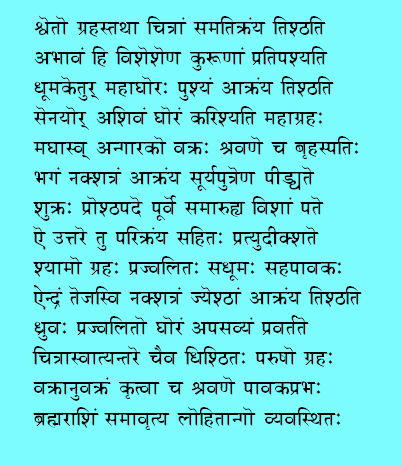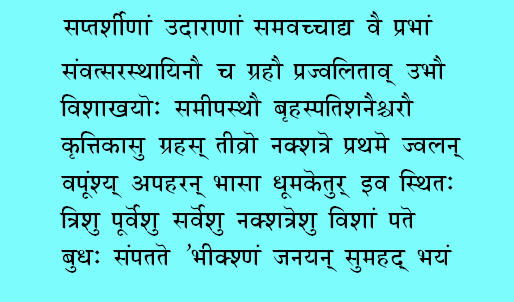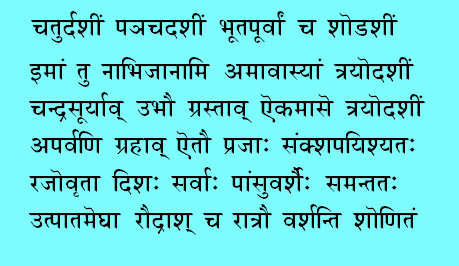 |
 |
|||||||||
|
||||||||||
Mahabharata epic story was written by, Vedavyaasa (or Krishna Dwaipaayana) after the Mahabharata battle. Vyaasa is also credited with codifying the existing branches of Vedas. It is perhaps the longest poem of its kind of such antiquity. The presently known oldest version of Mahabharata, based on its style, grammar and other feature was probably written down before the Gupta period. This Mahabharata text does not refer to any Zodiac’s or raashis (a western concept probably accommodated in to Jyotishya some time during 300BC to 200AD). The linguistic style of the oldest version of Mahabharata clearly cannot be the basis for determining if and when the events of Mahabharata occurred. It probably may have been rewritten/re-rendered many times as the mode of transference was by oral traditions is in the case of Vedic chandas prosody). This version has nearly 90,000 to 100,000 kavya poems dominantly with 32 syllable Anushtup chandas. There are 18 chapters called Parva. The presently known oldest Sanskrit version is available in many scripts of India (52 alphabet scripts of Nagari, Bengali, Telugu, Kannada, Oriya, Gujarati, Punjabi and many others author may not be aware) during 18-19th centuries. They have been extensively transliterated, translated, analyzed and commented. The Bhishma Parva and Udyoga Parva (specific chapters of Mahabharata) provide considerable astronomical/astrological descriptions and omens as the Mahabharata war was approaching and during the war. It describes a period of draught, with many planetary positions. An electronic version has is available courtesy of Bhandarakar Institution in Pune, India, which has been used below. A literal translation of Bhishma Parva III-12-18 is as follows. Both Ref 4 and Ref 5 provide very similar texts as,
A white planet has passed Chitra (Spica). A fierce looking comet has passed Pushya (Early cancer). Mars is near Magha (Regulus) and is in retrograde motion. Brihaspathi(Probably Jupiter) is near Shravana (Deneb AlGeidi in Capricorn), Sun’s son (Shani) is near Bhaga-Poorva Phalguni (Denebola/chort), Shukra (Venus) is near Poorva Proshtapada (early Pisces), A white planet with smoky look has passed Jyeshta (Antares), Dhruva (Polaris) is wickedly bright, Both Sun and Moon are near Rohini (Aldebaran), A manly planet is between Chitra and Swati (Spica and later Virgo) and the red bodies planet is also near Shravana with Brishaspti(Jupiter) in a long retrograde motion etc … Some of the planetary position statements appear to be contradictions with precise meaning of where they were is not fully clear as in the case of shani and Brihaspati
Those two blazing planets Shani and Brihaspti having approached Vishaka (Zubenel genubi in Linbra) have remained stationary (retrograde motion) for a whole year etc …. Then there is this clear reference to pair of eclipses occurring on 13th day as shown below.
Fourteenth day, Fifteenth day and in past sixteenth day, but I have never known the Amavasya (New Moon day) to occur on the thirteenth day. Lunar eclipse followed by solar eclipse on thirteenth day is in a single month etc….. This astronomical reference "thirteen day" eclipse pair appears to be a unique astronomical observation. One interpretation is that a lunar eclipse occurred first followed by a solar eclipse on the 13th day after lunar eclipse. It also states that two eclipses occurred in one lunar month. Further, during the war Jayadhrata was killed during evening of 13th day of war in an evening dark episode, on a clear day, which may have been a short solar eclipse occurring and concluding before sunset. This is detailed in Drona Parva. The war occurred over a period of 18 days in a place called Kuruxethra. This document is basically concerned with analysis of all eclipses visible at Kuruxethra in North Bharata (Location where Mahabharata war took place, located north of New Delhi, Longitude 76 deg 49 min East, Latitude 29 deg 59 Min North) from 3300 BC to about Buddha-Mahavira-Parshvanaatha time of about 700BC. Analysis of the time between successive eclipses, specifically time between end of one and beginning of other has been made, with a view to look at astronomical feasibility of back-to-back eclipses in 13 days using modern computer software. Another major issue of how did observers of the period define and determine period between eclipses when no clocks existed, has been addressed.
|
||||||||||||


